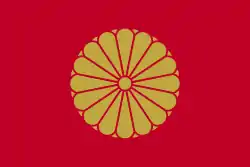Emperor Ōjin
Emperor Ōjin (応神天皇, Ōjin-tennō), also known as Hondawake no Mikoto (誉田別尊) or Homuta no Sumeramikoto (譽田天皇), was the 15th legendary Emperor of Japan, according to the traditional order of succession.[3][4]
| Ōjin | |||||
|---|---|---|---|---|---|
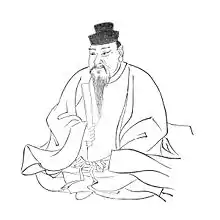 | |||||
| Emperor of Japan | |||||
| Reign | 270–310 (traditional)[1] | ||||
| Predecessor | Jingū (de-facto)[lower-alpha 1] Chūai (traditional) | ||||
| Successor | Nintoku | ||||
| Born | 201[2] Umi (Fukuoka) | ||||
| Died | 310 (aged 108–109) Karushima no Toyoakira (Nara) | ||||
| Burial | Eega no Mofushi no oka no misasagi (惠我藻伏崗陵) (Osaka) | ||||
| Spouse | |||||
| Issue | See below | ||||
| |||||
| House | Imperial House of Japan | ||||
| Father | Emperor Chūai | ||||
| Mother | Empress Jingū | ||||
| Religion | Shinto | ||||
No firm dates can be assigned to this Emperor's life or reign, but he is conventionally considered to have reigned from 270 to 310.[5] According to the Shinto religion and Buddhism in Japan, Emperor Ōjin is the divine spirit of the deity Hachiman (八幡神).
Legendary narrative
The Japanese have traditionally accepted this sovereign's historical existence, and a mausoleum (misasagi) for Ōjin is currently maintained. The following information available is taken from the pseudo-historical Kojiki and Nihon Shoki, which are collectively known as Kiki (記紀) or Japanese chronicles. These chronicles include legends and myths, as well as potential historical facts that have since been exaggerated and/or distorted over time. The circumstances surrounding the future emperor's birth are controversial as they allegedly involve the invasion of the Korean Peninsula. It is said by the Kiki that Ōjin was conceived but unborn when his father Emperor Chūai died. Empress Jingū then became a de-facto ruler who allegedly invaded a "promised land" (Korea) out of revenge, then returned three years later to the Japanese mainland to give birth. The records state that Ōjin was born to Empress Jingū in Tsukushi Province sometime in 201 AD, and was given the name Homutawake (誉田別尊). He became the crown prince at the age of four, but was not crowned Emperor until 270 AD at the age of 70. Emperor Ōjin supposedly lived in two palaces which are now located in present-day Osaka. His reign lasted 40 years until his death in 310 AD, in all he fathered 28 children with one spouse and ten consorts. His fourth son Ōosazaki was later enthroned as the next emperor in 313 AD.[6]
Known information
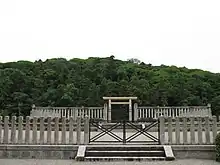
While the historical existence of Emperor Ōjin is debated among historians, there is a general consensus that he was "probably real". There is also an agreement that Ojin's three year conception period is mythical and symbolic, rather than realistic. William George Aston has suggested that this can be interpreted as a period of less than nine months containing three "years" (some seasons), e.g. three harvests.[7] If Ōjin was an actual historical figure then historians have proposed that he ruled later than attested.[8][9][10] Dates of his actual reign have been proposed to be as early as 370 to 390 AD, to as late as the early 5th century AD.[8] At least one Japanese historian has cast doubt on this theory though, by revising a supporting statement given in 1972. In this new narrative Louis Perez states: "only kings and emperors after the reign of Ojin... ...are seen as historical figures".[11][12] In either case there is also no evidence to suggest that the title tennō was used during the time to which Ōjin's reign has been assigned. It is certainly possible that he was a chieftain or local clan leader, and that the polity he ruled would have only encompassed a small portion of modern-day Japan. The name Ōjin-tennō was more than likely assigned to him posthumously by later generations.[13]
While the actual site of Ōjin's grave is not known, this regent is traditionally venerated at a kofun-type Imperial tomb in Osaka. The Imperial Household Agency designates this location as Ōjin's mausoleum, and is formally named Eega no Mofushi no oka no misasagi.[14] At some point Ōjin was made a guardian Kami of the Hata clan, and is now also deified as Hachiman Daimyōjin.[lower-alpha 2] Outside of the Kiki, the reign of Emperor Kinmei[lower-alpha 3] (c. 509 – 571 AD) is the first for which contemporary historiography has been able to assign verifiable dates.[16] The conventionally accepted names and dates of the early Emperors were not confirmed as "traditional" though, until the reign of Emperor Kanmu[lower-alpha 4] between 737 and 806 AD.[17]
Family
Emperor Ōjin's family allegedly consisted of 28 children, which include 2 unnamed princesses from a previous marriage. He had one spouse who bore him a son that would become the next Emperor, as well as 10 consorts.
Spouse & concubines
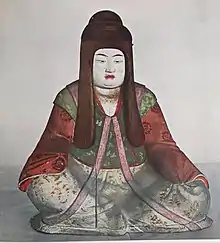
| Position | Name | Father | Issue |
|---|---|---|---|
| Kōgō | Nakatsu-hime (仲姫命) | Homudamawaka | • Princess Arata • Prince Netori • Prince Ōosazaki[lower-alpha 5] (later Emperor Nintoku) |
| Consort | Takakiiri-hime (高城入姫命) | Homudamawaka | • Prince Izanomawaka • Princess Komukuta • Prince Nukata no Ōnakatsuhiko • Princess Ohara • Prince Ōyamamori |
| Consort | Oto-hime (弟姫命) | Homudamawaka | • Princess Ahe • Princess Awaji no Mihara • Princess Ki no Uno • Princess Mino no Iratsume • Princess Shigehara |
| Consort | Miyanushiyaka-hime (宮主宅媛) | Wani no Hifure no Omi | • Princess Metori • Prince Uji no Wakiiratsuko • Princess Yata |
| Consort | Onabe-hime (小甂媛) | Wani no Hifure no Omi | • Princess Uji no Wakiiratsu-hime |
| Consort | Okinaga Mawakanakatsu-hime (息長真若中比売) | Kawamata Nakatsuhiko | • Prince Wakanuke no Futamata |
| Consort | Ito-hime (糸媛) | Sakuraitabe no Muraji Shimatarine | • Prince Hayabusawake |
| Consort | Himuka no Izumi no Naga-hime (日向泉長媛) | Unknown | • Princess Hatabi no Wakairatsume • Prince Ōhae • Prince Ohae |
| Consort | Kaguro-hime (迦具漏比売) | Sumeiroōnakatsuhiko[lower-alpha 6] | • Prince Kataji • Princess Kawarata no Iratsume • Princess Tama no Iratsume |
| Consort | Katsuragi no Irome (葛城野伊呂売) | Takenouchi no Sukune | • Prince Izanomawaka[lower-alpha 7] |
| Consort | E-hime (兄媛) | Kibi-no-Takehiko | N/A |
Issue
| Status | Name | Mother | Comments |
|---|---|---|---|
| Princess | Arata (荒田皇女) | Nakatsu-hime | Very little is known about this person. |
| Prince | Ōosazaki (大鷦鷯尊) | Nakatsu-hime | Would later become Emperor Emperor Nintoku. |
| Prince | Netori (根鳥皇子) | Nakatsu-hime | Ancestor of Ōta no Kimi (大田君), married Princess Awaji no Mihara (see below). |
| Prince | Izanomawaka (去来真稚皇子) | Takakiiri-hime | Ancestor of Fukakawawake (深河別). |
| Prince | Nukata no Ōnakatsuhiko (額田大中彦皇子) | Takakiiri-hime | Very little is known about this person. |
| Prince | Ōyamamori (大山守皇子) | Takakiiri-hime | Ōyamamori died in 310 AD.[lower-alpha 8] |
| Princess | Komukuta (澇来田皇女) | Takakiiri-hime | Very little is known about this person. |
| Princess | Ōhara (大原皇女) | Takakiiri-hime | Very little is known about this person. |
| Princess | Ahe (阿倍皇女) | Oto-hime | Very little is known about this person. |
| Princess | Awaji no Mihara (淡路御原皇女) | Oto-hime | Married to Prince Netori |
| Princess | Ki no Uno (紀之菟野皇女) | Oto-hime | Very little is known about this person. |
| Princess | Mino no Iratsume (三野郎女) | Oto-hime | Very little is known about this person. |
| Princess | Shigehara (滋原皇女) | Oto-hime | Very little is known about this person. |
| Prince | Uji no Wakiiratsuko (菟道稚郎子皇子) | Miyanushiyaka-hime | Uji was a Crown Prince. |
| Princess | Metori (雌鳥皇女) | Miyanushiyaka-hime | Metori died in 353 AD, and was married to Prince "Hayabusawake" (see below). |
| Princess | Yata (矢田皇女) | Miyanushiyaka-hime | Yata was later married to Emperor Nintoku. |
| Princess | Uji no Wakiiratsu-hime (菟道稚郎女皇女) | Onabe-hime | Uji was later married to Emperor Nintoku. |
| Prince | Wakanuke no Futamata (稚野毛二派皇子) | Okinaga Mawakanakatsu-hime | Ancestor of Okinaga clan (息長君), amd great-grandfather of Emperor Keitai. |
| Prince | Hayabusawake (隼総別皇子) | Ito-hime | Hayabusawake was the husband of Princess Metori (雌鳥皇女). |
| Prince | Ōhae (大葉枝皇子) | Himuka no Izumi no Naga-hime | Very little is known about this person. |
| Prince | Ohae (小葉枝皇子) | Himuka no Izumi no Naga-hime | Very little is known about this person. |
| Princess | Hatabi no Wakairatsume (幡日之若郎女) | Himuka no Izumi no Naga-hime | Hatabi was later married to Emperor Richū |
| Princess | Kawarata no Iratsume (川原田郎女) | Kaguro-hime | Very little is known about this person. |
| Princess | Tama no Iratsume (玉郎女) | Kaguro-hime | Very little is known about this person. |
| Prince | Kataji (迦多遅王) | Kaguro-hime | Very little is known about this person. |
| Prince | Izanomawaka (伊奢能麻和迦王 - 去来真稚皇子) | Katsuragi no Irome | Very little is known about this person. |
See also
| Wikimedia Commons has media related to Emperor Ōjin. |
- Emperor of Japan
- Hachiman
- List of Emperors of Japan
- Imperial cult
Notes
- Jingū's reign as Empress is now confined to legends rather than fact. Modern historians have labeled her as an "Empress regent", who was the de-facto ruler until Homutawake (Ōjin) became emperor.
- Ōjin's Hachiman name is translated to "Guardian of warriors"
- The 29th Emperor[4][15]
- Kanmu was the 50th sovereign of the Yamato dynasty
- It is only known that "Ōosazaki" was the Fourth son of Emperor Ōjin. No mention is given about a numerical order of sons or daughters other than this historical footnote.
- Additionally, there are 2 more unnamed princesses speculated to be Prince "Wakanuke no Futamata"s daughters.
- This is unconfirmed
- Ōyamamori is also known as being an ancestor of Hijikata no Kimi (土形君) and Haibara no Kimi (榛原君).
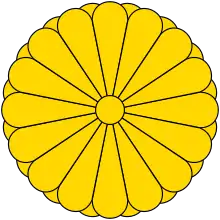
References
- "Genealogy of the Emperors of Japan" (PDF). Kunaicho.go.jp. Retrieved December 30, 2019.
- Kenneth Henshall (2013). Historical Dictionary of Japan to 1945. Scarecrow Press. p. 487. ISBN 9780810878723.
- "応神天皇 (15)". Imperial Household Agency (Kunaichō) (in Japanese). Retrieved January 6, 2020.
- Titsingh, Isaac. (1834). Nihon Ōdai Ichiran (in French). Royal Asiatic Society, Oriental Translation Fund of Great Britain and Ireland. pp. 19–22, 34–36.
- Ponsonby-Fane, Richard (1959). The Imperial House of Japan. Ponsonby Memorial Society. p. 36.
- Aston, William George. (1998). Nihongi, p. 254–271.
- Aston, William. (1998). Nihongi, Vol. 1, pp. 224–253.
- Kelly, Charles F. "Kofun Culture". www.t-net.ne.jp. Retrieved August 2, 2019.
- Jestice, Phyllis G. (2004). Holy People of the World: A Cross-cultural Encyclopedia, Volumes 1-3. ABC-CLIO. p. 653. ISBN 9781576073551.
- Wakabayashi, Tadashi (1995). Japanese loyalism reconstrued. University of Hawaii Press. p. 108. ISBN 9780824816674.
- Mikiso, Hane (1972). Japan; a Historical Survey. Scribner. p. 32.
- Louis Perez (2018). Premodern Japan: A Historical Survey. Routledge. ISBN 9780429974441.
- Brinkley, Frank (1915). A History of the Japanese People from the Earliest Times to the end of the Meiji Era. Encyclopaedia Britannica Company. p. 21.
Posthumous names for the earthly Mikados were invented in the reign of Emperor Kanmu (782–805), i.e., after the date of the compilation of the Records and the Chronicles.
- Ponsonby-Fane, p. 419.
- Brown, Delmer M. and Ichirō Ishida (1979). A Translation and Study of the Gukanshō, an Interpretative History of Japan Written in 1219. University of California Press. pp. 248, 261–262. ISBN 9780520034600.
- Hoye, Timothy. (1999). Japanese Politics: Fixed and Floating Worlds. Prentice Hall. p. 78. ISBN 9780132712897.
According to legend, the first Japanese Emperor was Jimmu. Along with the next 13 Emperors, Jimmu is not considered an actual, historical figure. Historically verifiable Emperors of Japan date from the early sixth century with Kimmei.
- Aston, William George. (1896). Nihongi: Chronicles of Japan from the Earliest Times to A.D. 697, Volume 2. The Japan Society London. p. 109 & 217–223.
Further reading
- Aston, William George. (1896). Nihongi: Chronicles of Japan from the Earliest Times to A.D. 697. London: Kegan Paul, Trench, Trubner. OCLC 448337491
- Brown, Delmer M. and Ichirō Ishida, eds. (1979). Gukanshō: The Future and the Past. Berkeley: University of California Press. ISBN 978-0-520-03460-0; OCLC 251325323
- Chamberlain, Basil Hall. (1920). The Kojiki. Read before the Asiatic Society of Japan on April 12, May 10, and June 21, 1882; reprinted, May 1919. OCLC 1882339
- Ponsonby-Fane, Richard Arthur Brabazon. (1959). The Imperial House of Japan. Kyoto: Ponsonby Memorial Society. OCLC 194887
- Titsingh, Isaac. (1834). Nihon Ōdai Ichiran; ou, Annales des empereurs du Japon. Paris: Royal Asiatic Society, Oriental Translation Fund of Great Britain and Ireland. OCLC 5850691
- Varley, H. Paul. (1980). Jinnō Shōtōki: A Chronicle of Gods and Sovereigns. New York: Columbia University Press. ISBN 978-0-231-04940-5; OCLC 59145842
- Wakabayashi, Tadashi. (1995). Japanese loyalism reconstrued: Yamagata Daini's Ryūshi shinron of 1759. Honolulu: University of Hawaii Press. ISBN 9780824816674; OCLC 31078696
| Regnal titles | ||
|---|---|---|
| Preceded by Emperor Chūai |
Emperor of Japan: Ōjin 270–310 (traditional dates) |
Succeeded by Emperor Nintoku |
